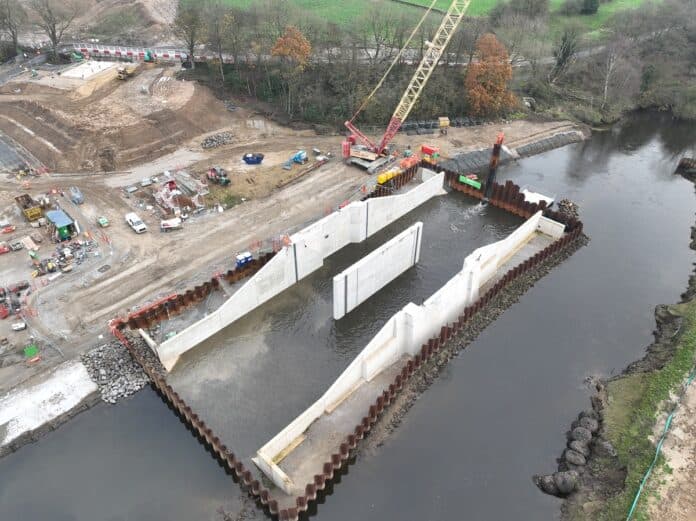Work has continued to progress on multi-million pound flood defences on the banks of River Aire in West Leeds.
Council chiefs say work will have an ‘enormous impact’ next winter, providing protection from floods in the Kirkstall Valley and beyond. The defences follow the devastating 2015 Boxing Day floods which saw the River Aire break its banks and flood businesses in the area.
But in an update from Leeds City Council today, the authority says the Leeds Flood Alleviation Scheme Phase 2 (FAS2) continues to progress ‘at pace’, with construction work officially under way across each of the 12 zones.

Significant 2022 milestones include:
- The installation of floating vegetated riverbanks near Leeds City Station to aid biodiversity in the area.
- Ground being broken at the Kirkstall Bridge Inn, Kirkstall Meadows, the area around Kirkstall Abbey and Apperley Bridge.
- Carefully moving historical artefacts at the Leeds Industrial Museum in Armley to enable the start of works there.
- The reopening of Milford Place footbridge in Kirkstall to reinstate pedestrian access across the river
- and the completion of the first flood cell at Redcote Lane in Burley, protecting a substation responsible for the power of thousands of homes.
Another major milestone is the completion of concrete works at the flood storage area near Calverley, which allowed for the removal of the Cofferdam (dry working area), resulting in water flowing over the structure for the first time:
Leeds FAS2 is due to complete in late 2023, protecting 1,048 homes, 474 businesses and key infrastructure along a 14km stretch from Leeds City Station to Apperley Bridge.
Once complete, the scheme will reduce the risk of flooding to a 0.5% chance of occurring in any given year, including a climate change allowance. The area currently protected by Leeds FAS1 will also have its level of protection upgraded to the same standard.
Alongside the more traditional engineering work, a catchment-wide natural flood management scheme is being rolled out. This features tree planting and soil aeration throughout the entire Upper Aire Catchment, including near to the source of the River Aire in Malham.
It’s hoped these measures will enhance the effectiveness of the flood alleviation scheme in Leeds by further reducing river levels over time, mitigating the impact of climate change up to 2069.
Councillor Helen Hayden, Leeds City Council’s executive member for infrastructure and climate, said:
“The progress made on the Leeds FAS2 is impressive, there have been some amazing feats of engineering, as well as many examples of the team working with landowners and residents to complete the scheme with minimal disruption.
“These successes have attracted the attention of authorities across the country, we have recently hosted Newcastle City Council and Shropshire Council to share the learning from such an ambitious project.
“The innovations in Natural Flood Management and other green methods including the floating riverbanks and massive amount of tree planting and soil aeration are a great example of our dedication to tackling the climate emergency.
“In Winter 2023, the completion of FAS2 will have an enormous impact on the flood resilience for thousands of people in Leeds. Our work will not stop there, we have a programme of works that will continue to address flooding all over the city for years to come and ensure that we are increasing our resilience in ways that also adds value to people and wildlife across the city.
“Despite all the progress we have made, it is important to remember that we must all stay vigilant, and make plans to protect ourselves from flooding, be that in our homes, our place of work or when travelling.”
The council also says there will be ‘ongoing consultation and modelling’ for new flood defence schemes in Wortley, where the beck regularly floods.
The last three months of 2022 saw higher-than-average rainfall and high river levels across Leeds. Figures for January 2023 are also on course to be wetter than average.
As a result, the council is encouraging all affected Leeds residents and business owners to consider the following steps:
- Create a flood plan for your home or business using the template from the Environment Agency.
- Sign up for flood alerts in your area for free on gov.uk.
- Read guidance on the different types of flood warnings, and what they mean for your home or your travel plans.
Sponsored content


